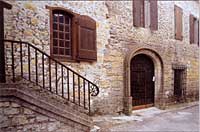The Cathar Creed
This was a new version of an old approach to Christianity. It made its appearance in Europe early in the 12th Century. In reality it was a Christianised version of the ‘dualism’ of more ancient eastern religions. It migrated from the Balkans to Italy, Germany, and France, moving southwards until it found its most fertile ground in the tolerant and somewhat anarchic atmosphere of Languedoc. There it spread steadily, to the increasing consternation of Rome, until, by the beginning of the 13th Century it was an accepted alternative to Catholicism throughout most of the region.
The first devotees called themselves ‘paupers of Christ’ but such was their prestige amongst the villagers and townsfolk they were simply known as ‘Les Bons Hommes’ or ‘The Good Men’. The Pope sent missionaries to try to dissuade them from their folly, but to no avail. Then an orthodox priest in his sermon mockingly called them ‘Cathars’ or ‘pure ones’ and somehow the term stuck, much to the chagrin of the Church. Thereafter the Catholic Church avoided the name, preferring to call them Albigenses or simply damning them as heretics.
For the Cathars there were two creating spirits in the universe eternally opposed to each other. The first was God, who had implanted spiritual goodness in everyone. The other was the Devil, who was responsible for creating the world and all its materialistic evils including man himself. God had cast Satan out of Paradise, whereupon Satan had entrapped the angelic essence of God and had created Man as its fleshly prison. Thus there was a part of God trapped in all men and women, longing to rejoin its Maker. The Devil deliberately filled Man with temptations in order to frustrate his soul from ever making that reunion.
Enmeshed in its human cage, this angelic spirit could be tortured by disease, famine and all manner of disasters, including man’s own inhumanity to his fellows. However, the Devil had no power over the soul. His remit was confined to earthly things. Any hell that existed was right here, on an earth that appeared so solid but was in fact so transient. To discomfort the Devil it was necessary to abstain from all earthly temptations and to strengthen the inner spirit by prayer. It was a persuasive argument and it seemed to provide a logical reason for all the misfortunes of the world.
The Cathar ‘parfaits’ or priests dismissed the Old Testament as a mistaken portrayal of a vindictive and cruel god prone to tribal prejudice rather than radiating universal love. They particularly embraced the concept of the Lord as revealed by St.John and carried his testament with them wherever they went. They made no monetary demands on their followers, but lived humble and simple lives working as tradesmen, frequently weavers, amongst their community. They travelled on foot from place to place, preaching, without the aid of impressive buildings or expensive robes. They were vegetarians and abhorred killing of any kind. Sexual contact was avoided, but women were free to become parfaits and often did. It was a creed of complete detachment from the material world and it was all the more appealing because the ‘perfecti’ did not expect their ‘credentes’ or followers, to adopt their severe lifestyle.

The house of Saint Dominic in Fanjeaux
Dominic Guzman took up residence here in the heart of Cathar Languedoc between 1211 and 1214. He argued eloquently and passionately for the Cathar heretics to return to the Church of Rome, but was singularly unsuccessful. However, he did persuade some women to return to the Church and was able to found a nunnery for them at nearby Prouille.
In an age when so many orthodox priests were living a life of licentious luxury the austere example set by the parfaits came as a breath of fresh air to rich and poor alike in the castles and villages of Languedoc.
Both nobles and peasants were eager to give them what hospitality they could, simply to listen to their teachings and it was not long before every town in the Midi possessed its own Cathar community. Several noble lords and ladies received the ‘consolamentum’ and became Cathars themselves and their prestige gave respectability to the spreading faith. Raymond-Roger, Count of Foix was a noted Cathar sympathiser and both his wife and sister Esclarmonde were parfaits.
Toulouse was the largest, and most prosperous city in Languedoc. The rural areas were mostly anti Church of Rome and sympathised with the Cathars, but Toulouse was split between the two. Free of control from any central government, its growing importance and increasing revulsion to the Catholic Church was fast making Toulouse an independent political and religious power in its own right.
It was this growth of a rival power to the Holy City that so alarmed Pope Innocent. In far off Rome he expressed his concern in a letter that echoes the rantings of violent dictators the world over.
“…The ingrained corruption of abominable heresy continues to grow in Toulouse, breeding monstrous offspring... ulcers that do not respond to dressings must be cut out with a knife... Those who hold cheap the correction of the Church must be crushed by its power”
To his eyes the Cathars were an unmistakeable threat and so he began his preparations to exterminate this gentle, but far too popular rival.